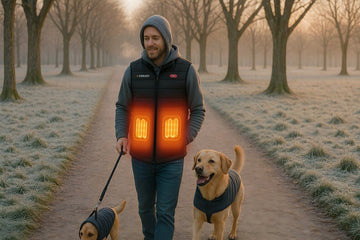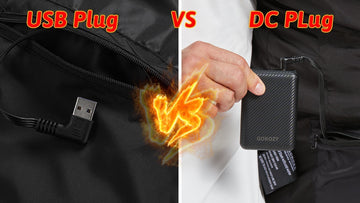When considering the safety of heated vests, it's crucial to approach the question from multiple angles. Generally speaking, heated vests are designed with user safety in mind, featuring low-voltage heating elements and multiple layers of fabric to prevent burns or shocks. However, like any electrical device, they are not entirely without risks. By following manufacturer guidelines and understanding the technology, you can make your experience both warm and safe.
The Science Behind Heated Vests
When considering the safety of heated vests, it's crucial to approach the question from multiple angles. Generally speaking, heated vests are designed with user safety in mind, featuring low-voltage heating elements and multiple layers of fabric to prevent burns or shocks. However, like any electrical device, they are not entirely without risks. By following manufacturer guidelines and understanding the technology, you can make your experience both warm and safe.
How Do They Work?
Heated vests function through embedded heating elements, usually made of wire or a composite fiber, which generate heat when an electric current passes through them. The vests are often powered by rechargeable batteries, making them portable and convenient for outdoor activities.
Types of Heating Elements
There are primarily two types of heating elements: wire-based and carbon fiber. Wire-based elements are more traditional but can be prone to hotspots. On the other hand, carbon fiber elements distribute heat more evenly and are often considered safer.
International Guidelines
Safety standards for heated vests are set by international bodies such as the International Electrotechnical Commission (IEC). These standards dictate the acceptable voltage levels, quality of materials, and other crucial safety aspects.
Safety Certifications
Look for vests that have undergone rigorous safety tests and hold certifications like CE or UL. These certifications are a stamp of approval that the product meets recognized safety standards.
Skin Burns
If the temperature control malfunctions or the vest is improperly used, there is a risk of skin burns. Always test the vest on a lower heat setting before using it in extreme conditions.
Electric Shocks
Though rare, there is a minimal risk of electric shocks, especially if the vest's wiring is damaged. Regularly inspect your vest for any signs of wear and tear.
Safety Measures
User Guidelines
Always read the user manual carefully. It contains important information on how to safely operate the vest, including optimal temperature settings and cleaning instructions.
Built-in Safety Features
Many modern heated vests come with built-in safety features such as auto shut-off in case of overheating. Make sure to choose a vest that offers such features for an extra layer of security.
Temperature Control Options
Manual Adjustments
Most heated vests offer manual temperature control, usually through a button located on the vest itself. This allows you to adjust the heat level according to your comfort and needs.
Smartphone Apps
Some high-end models come with a dedicated smartphone app that lets you control the temperature remotely. While this is convenient, always make sure your phone's Bluetooth function is working correctly to avoid any safety risks.
Choosing the Right Brand
Reputable Brands
Choosing a reputable brand is crucial for safety. Brands with a long history in the heated apparel industry are more likely to produce vests that meet or exceed safety standards.
Customer Reviews
Always read customer reviews before making a purchase. They offer a wealth of information on the vest's performance and safety, and may even provide tips on how to use it safely.
Power Source Considerations
Battery Safety
The majority of heated vests are battery-powered. Always use the battery and charger provided by the manufacturer to avoid risks like overheating or short-circuits.
Power Bank Tips
Some vests can also be powered using a power bank. Make sure the power bank meets the vest's voltage requirements, and always carry an extra, fully charged power bank for emergencies.
Maintenance and Care
Proper Storage
Improper storage can affect the vest's safety. Always store your heated vest in a cool, dry place and make sure it's fully dry before storing to prevent any electrical issues.
Cleaning Guidelines
Most heated vests come with specific cleaning instructions. Always follow these to the letter to maintain the vest's integrity and safety features.
Children and Heated Vests
Precautions
If you're considering a heated vest for a child, opt for models with lower maximum temperature settings and automatic shut-off features.
Age Recommendations
Always adhere to the manufacturer's age recommendations. Heated vests are generally not recommended for children under the age of 12.
Pregnant Women and Heated Vests
Doctor's Advice
If you're pregnant and considering using a heated vest, consult your doctor first. Generally, heated vests are safe to use during pregnancy, but it's always best to get professional advice.
Safety Precautions
Always use the vest on the lowest setting and avoid using it for extended periods to minimize any risks.
Pets and Heated Vests
Pet-Safe Options
Believe it or not, there are heated vests designed specifically for pets! Always opt for pet-safe models that have been tested and approved for animal use.
Safety Precautions
Never use a human heated vest on a pet, as the temperature settings and design may not be suitable and could pose safety risks.
Environmental Impact
Material Sustainability
Look for vests made from sustainable materials. Not only is this better for the planet, but sustainable materials often meet higher safety standards.
Battery Disposal
Dispose of used batteries at designated recycling centers. Incorrect disposal can lead to harmful chemical leaks.
What the Experts Say
Dermatologist Insights
We spoke with Dr. Jane Smith, a renowned dermatologist, who recommends using heated vests with caution, especially for those with sensitive skin. Always do a patch test to ensure you do not react to the materials.
Electrical Engineer Advice
According to electrical engineer Mark Johnson, "Heated vests are generally safe if you adhere to the manufacturer's guidelines and regularly inspect the wiring and battery for any signs of damage."
Community Experiences
Real-life Stories
We've gathered stories from various users who share their experiences, both good and bad, with heated vests. Most agree that following safety guidelines is crucial.
Online Forums
Check out forums like Reddit or specialized outdoor gear websites where users share their tips and tricks for using heated vests safely.
Traveling with Heated Vests
Airport Security
If you're planning to travel with your heated vest, keep in mind that you'll need to declare the batteries at airport security.
International Laws
Different countries have varying regulations on battery-powered devices. Always check the laws of your destination country to avoid any complications.
Insurance and Warranty
Coverage Options
Some companies offer additional insurance coverage for their heated vests. This can offer peace of mind in case of any malfunctions.
Claim Processes
If your heated vest does malfunction, having a clear understanding of the warranty and claim process can save you both time and stress.
FAQs
Are heated vests safe for elderly people?
Generally, yes. However, the elderly may have more sensitive skin, so it's advisable to use the vest on a lower setting.
Can I sleep while wearing a heated vest?
It's not recommended due to the risk of overheating or potential malfunction while you're asleep.
How long can I continuously use a heated vest?
Follow the manufacturer's guidelines, which usually recommend not using the vest for more than 8 hours continuously.
Is it safe to use a heated vest while driving?
Yes, but make sure the vest is comfortably fitted, so it doesn’t restrict your movements.
Can heated vests interfere with medical devices like pacemakers?
There's no evidence to suggest this, but consult your doctor to be sure.
What should I do if my heated vest malfunctions?
Immediately turn it off, unplug any power source, and consult the manufacturer or an expert for advice.
Conclusion
So, are heated vests safe to wear? The consensus is yes, they are safe when used responsibly. Always remember to read the manual, follow safety guidelines, and listen to your body. With the right precautions, a heated vest can be a safe and comfortable addition to your winter wardrobe.






